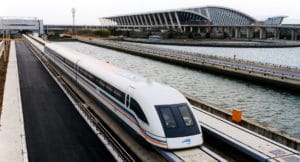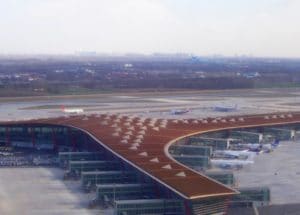
China’s high-speed rail (HSR) system started construction in the early 2000s.

By the end of 2018, high speed rail in China had over 29,000 kilometers (18,020 miles) of dedicated lines alone, a length that exceeds rest of the world’s high-speed rail tracks combined, making it the longest HSR network in the world. With an annual ridership of over 1.1 billion passengers in 2015 it is the world’s busiest. The network includes the Beijing–Guangzhou–Shenzhen High-Speed Railway, the single longest HSR line in the world, and the Beijing–Shanghai High-Speed Railway, which has three of longest railroad bridges in the world. The HSR track network is set to reach approximately 30,000 km (19,000 mi) by the end of 2019. The Shanghai Maglev Train, which reaches 431 km/h (268 mph), is the fastest commercial train service in the world. In May 2019, China released a prototype for a maglev high-speed train that would reach a speed of 600 km/hr (375 mph); and it is expected to go into commercial production by 2021.
Since 2000, the growth of rapid transit systems in Chinese cities has accelerated. As of January 2016, 26 Chinese cities have urban mass transit systems in operation and 39 more have metro systems approved with a dozen more to join them by 2020. The Shanghai Metro, Beijing Subway, Guangzhou Metro, Hong Kong MTR and Shenzhen Metro are among the longest and busiest in the world.

There were approximately 229 airports in 2017, with around 240 planned by 2020. More than two-thirds of the airports under construction worldwide in 2013 were in China, and Boeing expects that China’s fleet of active commercial aircraft in China will grow from 1,910 in 2011 to 5,980 in 2031. In just five years—from 2013 to 2018—China bought 1000 planes from Boeing. With rapid expansion in civil aviation, the largest airports in China have also joined the ranks of the busiest in the world. In 2018, Beijing’s Capital Airport ranked second in the world by passenger traffic (it was 26th in 2002). Since 2010, the Hong Kong International Airport and Shanghai Pudong International Airport have ranked first and third in air cargo tonnage.
Flag of China:
The flag of China, officially the National Flag of the People’s Republic of China and also known as the Five-starred Red Flag, is a Chinese red field charged in the canton (upper corner nearest the flagpole) with five golden stars. The design features one large star, with four smaller stars in a semicircle set off towards the fly (the side farthest from the flag pole). The red represents the “revolution”; the five stars and their relationship represent the unity of the Chinese people under the leadership of the Communist Party of China (CPC). The first flag was hoisted by the People’s Liberation Army (PLA) on a pole overlooking Beijing’s Tiananmen Square on October 1, 1949, at a ceremony announcing the establishment of the People’s Republic of China.
